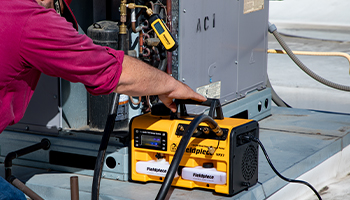
The use and placement of tools are critical to the success of maintaining or repairing HVACR systems. One misstep can lead to another, ultimately putting any system at risk and customers at a disadvantage when it comes to paying higher costs.
Whether you’re installing a whole new HVACR system or making repairs to an existing one, you need to evacuate the system before you can add new refrigerant. This means lowering the pressure down to a deep vacuum to ensure all moisture and non-condensable gasses are removed. If you don’t evacuate the system properly, moisture and non-condensable gasses that remain in the system will adversely affect system efficiency and may potentially lead to acid formation and critical component failure.
The best way to make sure that you pull a 500-micron vacuum, an industry-standard, is to use the ultimate power couple in HVACR service – the vacuum pump and vacuum gauge. Separately, they are amazing, powerful tools. Together, our best HVAC vacuum pump and best digital micron vacuum gauge offer a level of speed and accuracy that are truly game-changers for techs in the field.
To ensure that you’re using these tools correctly, keep these tips in mind:
1. Location, location, location: Choosing the placement of the vacuum gauge is key to pulling an accurate vacuum. Ideally, the vacuum gauge should be as far from the vacuum pump and connected at the system, preferably the service port, for a more accurate reading of the vacuum in the system. For a good single hose set up, consider installing the vacuum gauge on the liquid line and connecting the vacuum pump to the vapor line for optimal performance.
2. Clear every restriction: From small diameter hoses to valve cores, anything that restricts flow can slow down your evacuation. Before you start, remove the valve cores from the service port and use larger diameter vacuum-rated hoses to attach the pump. These will help speed up the entire process.
3. Know your readings: Today’s digital micron meters or vacuum gauges display instant, accurate data about pressure changes. When you’re pulling a vacuum, fluctuations in pressure are normal. Systems can take a while to equalize because there could be some outgassing or trapped moisture could be evaporating. Give the pump some time to work before you react to these minor fluctuations.
4. Use clean oil: If you’re removing a lot of moisture from a system, remember to replace the pump’s oil when it starts to look milky due to moisture or dirt. By always keeping the oil clean and dry, you allow the pump to maintain a greater pressure differential and pull a faster, deeper vacuum. Premium vacuum pumps allow the oil to be changed while the vacuum pump is running.
Pulling a vacuum to remove moisture and other impurities is part of life as a field technician in the HVACR industry. To thrive as a master of your trade, you need to know the right way to use a pump, the right way to place a vacuum gauge on your system and how to make HVACR’s power couple work best for you.